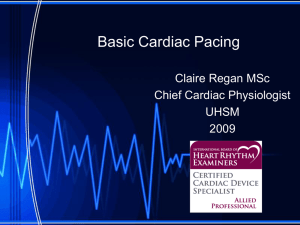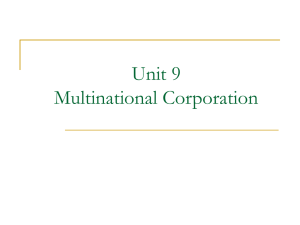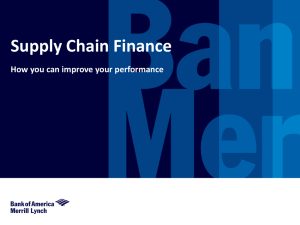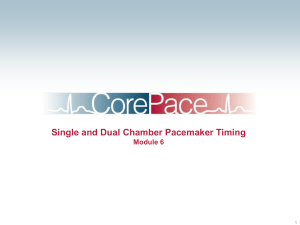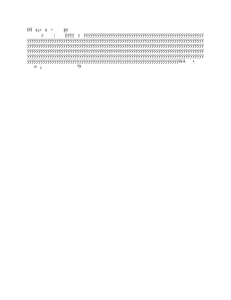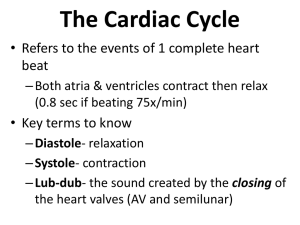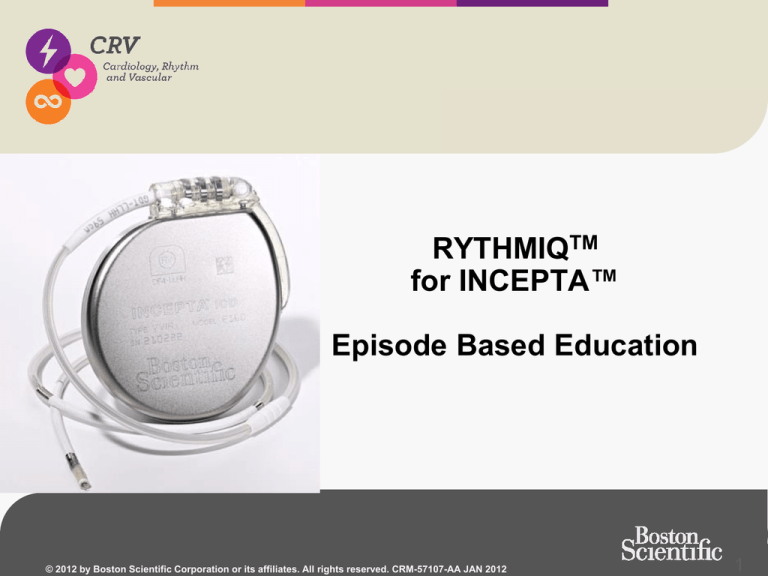
RYTHMIQTM
for INCEPTA™
Episode Based Education
© 2012 by Boston Scientific Corporation or its affiliates. All rights reserved. CRM-57107-AA JAN 2012
1
RYTHMIQ™ vs. AV SEARCH +
Based on IBP Recommendations
RYTHMIQ™ & AV Search + give you options to appropriately manage
RV pacing in patients with varying degrees of conduction block
AV Node
Atrial Arrhythmias
Feature Recommendations
Normal
None
RYTHMIQ
Normal
Paroxysmal/Persistent
RYTHMIQ
1st Degree
None
RYTHMIQ
1st Degree
Paroxysmal/Persistent
RYTHMIQ
2nd Degree
None
AV SEARCH +
2nd Degree
Paroxysmal/Persistent
AV SEARCH +
3rd Degree
None
Paced and Sensed AV Delays
3rd Degree
Paroxysmal/Persistent
Paced and Sensed AV Delays
(if Permanent
selected, single chamber mode is recommended)
Sinus Node status does not affect IBP recommendations on RYTHMIQ, AV SEARCH + or Paced
and Sensed AV Delays, unless Neurovascular Syndromes is selected
© 2012 by Boston Scientific Corporation or its affiliates. All rights reserved. CRM-57107-AA JAN 2012
AV Search +
Two Refinements of the Algorithm
AV Search
AV Search +
Results
With AV Search
Hysteresis, search is
initiated after the
programmed number of
consecutive paced
cycles.
AV Search + counts both
paced and sensed cycles
when determining when to
initiate the search.
More frequent
searches.
With AV Search
Hysteresis, search
remains in affect until a
single ventricular paced
cycle during extension
period occurs.
With AV Search +, the
search remains in affect until
two of ten ventricular paced
cycles occur during the
extension period.
Will stay at the
extension period for
longer periods of
time.
© 2012 by Boston Scientific Corporation or its affiliates. All rights reserved. CRM-57107-AA JAN 2012
AV Search + Programming
AV Delay Extension with Higher Maximum Tracking Rates
AV Search
AV Search +
AV Delay
= 200 ms
AV Delay
PVARP
= 250 ms
PVARP
AV Search
= 32 cycles AV Search
Hysteresis
Hysteresis
Search Interval
Search Interval
AV increase
= 100%
Search AV Delay
The Maximum
Tracking Rate
Allowed is
95 bpm
The Maximum
Tracking Rate
Allowed is
Results
= 200 ms
AV Search +
operates with
= 250 ms
longer AV
= 32 cycles delays over a
wider range of
patient heart
rates.
= 400 ms
130 bpm
For AV Search +, the Maximum Tracking Rate limit is determined by the programmed
AV Delay and PVARP (TARP), but the Search AV Delay is allowed to be longer since
the rhythm will typically be a conducted ventricular sense following the atrial event.
© 2012 by Boston Scientific Corporation or its affiliates. All rights reserved. CRM-57107-AA JAN 2012
RYTHMIQTM : Programmer Screens
© 2012 by Boston Scientific Corporation or its affiliates. All rights reserved. CRM-57107-AA JAN 2012
48
RYTHMIQTM Operation
“The following occurs during the RYTHMIQ™ stage of AAI(R) with VVI backup:
• The device provides AAI(R) at the LRL and/or sensor indicated rate according
to the normal brady DDD(R) mode.
• The device provides backup VVI pacing at a rate of 15 ppm slower than the
LRL. The backup VVI pacing rate is limited to no slower than 30 ppm and no
faster than 60 ppm. When there is good conduction, ventricular pacing does
not occur as the VVI backup mode runs in the background at a reduced LRL.
• The device monitors for loss of AV synchrony. If 3 slow ventricular beats are
detected in a window of 11 beats, then the device automatically switches to
DDD(R) mode. A slow beat for RYTHMIQ™ is defined as a ventricular pace or
ventricular sensed event that is at least 150 ms slower than the AAI(R) pacing
rate.”1 The 150 ms value is used to allow for normal variations between
cardiac cycles.
1Reference
Guide, INCEPTA ICD, Page 4-28, 358430-003 EN US 01/11
© 2012 by Boston Scientific Corporation or its affiliates. All rights reserved. CRM-57107-AA JAN 2012
9
RYTHMIQTM Example 1
The atrial lower rate limit is 55 bpm, which then makes the VVI rate limit 55 – 15 bpm, or 40 ppm.
© 2012 by Boston Scientific Corporation or its affiliates. All rights reserved. CRM-57107-AA JAN 2012
11
RYTHMIQTM Example 1
A PVC occurs which is not sensed because it falls in the atrial pacing blanking period.
© 2012 by Boston Scientific Corporation or its affiliates. All rights reserved. CRM-57107-AA JAN 2012
12
RYTHMIQTM Example 1
Pacing occurs at the VVI lower rate limit of 40 ppm or 1,500 ms. Slow ventricular beat #1.
Beat 1
© 2012 by Boston Scientific Corporation or its affiliates. All rights reserved. CRM-57107-AA JAN 2012
13
RYTHMIQTM Example 1
Pacing occurs again at the VVI lower rate limit of 40 ppm or 1,500 ms. Slow ventricular beat #2.
Beat 2
© 2012 by Boston Scientific Corporation or its affiliates. All rights reserved. CRM-57107-AA JAN 2012
14
RYTHMIQTM Example 1
A ventricular senses beat then occurs at 1,338 ms, which is slower than the atrial LRL of 55 bpm
plus 150 ms (1090 ms + 150 ms = 1240 ms). This is slow ventricular beat #3 in the last 11.
Beat 3
© 2012 by Boston Scientific Corporation or its affiliates. All rights reserved. CRM-57107-AA JAN 2012
15
RYTHMIQTM Example 1
RYTHMIQ™ transitions from AAI(R) mode to DDD(R) and an event with electrogram is stored.
DDD(R)
EGM Stored
© 2012 by Boston Scientific Corporation or its affiliates. All rights reserved. CRM-57107-AA JAN 2012
16
RYTHMIQTM Operation
AAI(R) at programmed LRL
VVI backup at LRL – 15 ppm,
bounded by [30,60]
Sustained
conduction
detected
3 slow ventricular beats in
moving window of last 11
Declare Event/Record EGM
Reference Guide, INCEPTA ICD, Page 4-28, 358430-003 EN US 01/11
© 2012 by Boston Scientific Corporation or its affiliates. All rights reserved. CRM-57107-AA JAN 2012
DDD(R) at
programmed LRL
RYTHMIQTM Operation
AAI(R) at programmed LRL
RYTHMIQ can detect
AFib from either AAI(R) or DDD(R)
VVI backup at LRL – 15 ppm,
bounded by [30,60]
Sustained
conduction
detected
3 slow ventricular beats in
moving window of last 11
DDD(R) at
programmed LRL
Declare Event/Record EGM
ATR Mode
Switch
Reference Guide, INCEPTA ICD, Page 4-28, 358430-003 EN US 01/11
© 2012 by Boston Scientific Corporation or its affiliates. All rights reserved. CRM-57107-AA JAN 2012

